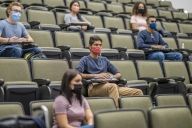You have /5 articles left.
Sign up for a free account or log in.

In a new survey, 51 percent of students said they are experiencing more stress and anxiety than they did last January.
Gary Coronado/Los Angeles Times via Getty Images
Almost nine in 10 college students think campuses are facing a mental health crisis, according to a new survey from TimelyMD, a student-first telehealth provider.
The survey of nearly 1,700 college students found that 88 percent believe there is a mental health crisis on college campuses. While each student might have a different understanding of what a mental health crisis is, it’s clear that students are suffering, said Alan Dennington, chief medical officer and co-founder of TimelyMD.
“I think that the perception of there being a crisis is around how many students a respondent knows, or themself, that feels like they have stress and anxiety and have mental health issues that they don’t feel are being met,” Dennington said.
Seventy percent of respondents said they’re experiencing emotional distress or anxiety due to the COVID-19 pandemic and/or the introduction of the Delta and Omicron variants. And 51 percent said they have more stress and anxiety than they did last January.
“Students went through the initial surge, and it had a deep impact on their education going remote and their college experience,” Dennington said. “It started to get better in the summer, and then Delta came as students were getting ready to go back to school, which created more fear and anxiety. And then as students started getting used to living with Delta, Omicron comes and the numbers are higher than they’ve ever been.”
Dennington was most surprised by the fact that student stress is higher this January than last January, he said, since people are used to the pandemic now, which could lead to lower stress levels. Instead, many students are feeling hopeless, Dennington said, despite the wide availability of COVID-19 vaccines.
“Last year this time, the vaccine was coming out, and it felt like there’s an end in sight,” Dennington said. “It was a much more optimistic feeling at that time and that we’d been through the worst … And now this year, it’s like, ‘Is this ever going to end?’”
Barb Solish, director of youth and young adult initiatives at the National Alliance on Mental Illness, said her organization has seen a similar trend.
“With the Omicron variant, the uncertainty and isolation that we saw at the beginning of the pandemic really is back,” Solish said. “And our students are struggling because of it. So, bottom line, how can we reasonably expect them to be back to ‘normal’ when life is anything but that?”
Dennington said the latest Omicron surge is adding to students’ anxiety and stress, with many feeling upset about not getting a typical college experience.
“‘Is the pandemic going to go on throughout my whole college career? Is it going to be four years that we’re going through this? Are we going to get back to some sense of normalcy at some point?’” Dennington said. “Omicron has had such big numbers that it’s caused administrators to make the decision to go back to virtual learning, so it kind of feels like a step backwards.”
A number of institutions are beginning their spring semesters online, and some have pushed their return-to-campus dates further out in response to the Omicron spike and breakthrough infections. The TimelyMD survey found that 44 percent of student respondents are starting their spring semesters in person and on campus, 27 percent are starting online and remote, and 29 percent have a hybrid start.
Among students whose institutions started remotely this semester, 58 percent said they thought it was the “right decision,” 24 percent said their institution should have resumed in person and 18 percent said students should have the choice of in-person or remote learning.
The survey also found that students are seeking more mental health help. Forty-eight percent of respondents said they want more remote mental and physical health services, and 41 percent said they want more remote social support and a greater sense of belonging.
College mental health systems were underfunded, understaffed and underprioritized before the pandemic started, Solish said, and they’re stretched even thinner now given the increased demand for their services.
“Schools really need to recognize that it’s time to invest in the total well-being of their students,” Solish said.
Institutions have made an effort to get the word out about the mental health services available, beefing up their websites and sending email blasts, Solish said. “But if the actual services aren’t there, or if they’re overwhelmed, it’s not all that helpful.”
Still, Dennington said it’s a good sign that students are trying to address their mental health issues. Sixty-four percent of students reported that they are seeking or intending to seek mental health help, and 58 percent reported they are spending time and talking in person with friends and family to cope with stress from the pandemic. Fifty-six percent said they’re communicating with friends and family via video or phone calls.
The TimelyMD survey respondents ranged in age from 18 to 29. Fifty-seven percent said they attend four-year public institutions, 24 percent attend four-year private institutions and 19 percent attend two-year institutions.
The survey also found that among institutions requiring a COVID-19 booster, 48 percent of respondents said they’re already boosted or planning to get a booster, and 17 percent said they got boosted because of their institution’s mandate. Twenty-four percent said their institution doesn’t require a COVID-19 booster.
When asked to name the specific pandemic-related factors causing them stress and anxiety, 54 percent of respondents cited the impact on the quality of their education, and the same share cited the impact on their social life; 34 percent named the impact on their ability to work. Dennington said such responses raise questions about how the pandemic will affect students in the long term.
“Students have fear around how the pandemic is affecting their success,” Dennington said. “I think it’s yet to be seen whether or not that really will affect their success and whether they’ll be ill prepared for the professional life when they finish college. They very well could still be getting the same quality of education, but they may not feel like they are.”
Dennington said the biggest step institutions can take to address student mental health is to make sure they have adequate mental health services available—and that students know how to access those services.
“Make sure the students feel supported,” Dennington said. “There’s an empathy that the institutions can have with the students … and we know this has an impact—‘We’re here for you and here are the things that we’re providing for you to help you get through this.’”








